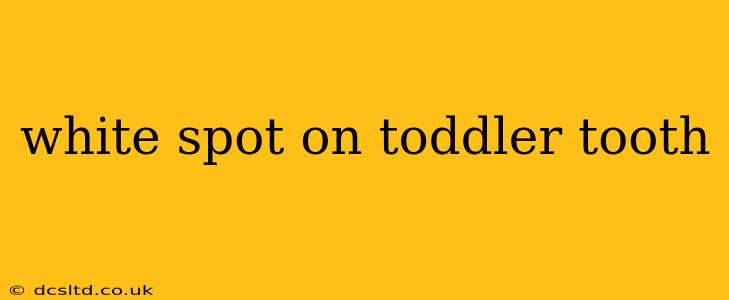A white spot on your toddler's tooth can be alarming, but it's important to understand that several factors can cause this. While some are harmless, others require professional dental attention. This comprehensive guide will explore the various reasons for white spots on toddler teeth, helping you determine when to seek professional help.
What Causes White Spots on Toddler Teeth?
White spots on a child's teeth are often a sign of demineralization, meaning the tooth enamel is losing its minerals. This weakening of the enamel makes the tooth more susceptible to cavities. Several factors contribute to this:
-
Early Childhood Caries (ECC): Also known as baby bottle tooth decay, ECC is a severe form of tooth decay affecting infants and toddlers. Prolonged exposure to sugary liquids like juice, milk, or formula, especially during nighttime feedings, contributes significantly to ECC. The sugar feeds bacteria, producing acids that erode tooth enamel, resulting in white spots as the first visible sign.
-
Fluorosis: While fluoride strengthens teeth, excessive fluoride intake can cause fluorosis. This manifests as white spots or streaks on the teeth, often appearing during tooth development. The severity depends on the amount and duration of fluoride exposure. Mild fluorosis is usually just cosmetic, while severe cases can affect tooth structure.
-
Hypocalcification: This is a developmental issue where the enamel doesn't properly mineralize during tooth formation. It results in white spots or patches that are usually more noticeable on the permanent teeth. While it's not directly caused by external factors like diet, genetic predisposition can play a role.
-
Molar Incisor Hypomineralization (MIH): This is a relatively common developmental defect affecting the first permanent molars and incisors. It causes enamel to be softer and more prone to discoloration, including white spots. The exact cause of MIH is unknown, but several factors, including illness during tooth development, have been suggested.
Is a White Spot on My Toddler's Tooth a Cavity?
A white spot isn't automatically a cavity, but it's a strong indicator of potential decay. The spot represents an area where enamel has begun to demineralize. If left untreated, the demineralization will progress, leading to a cavity (a hole in the tooth). Early intervention is crucial to prevent further damage.
How to Treat White Spots on Toddler Teeth?
The treatment depends on the underlying cause:
-
For ECC and early cavities: Your dentist might recommend fluoride treatments, sealants (to protect the enamel), or, in severe cases, fillings or extractions. Regular dental check-ups and good oral hygiene are vital.
-
For Fluorosis: In mild cases, no treatment is necessary, as it's mainly a cosmetic concern. Severe cases might require professional whitening or other cosmetic procedures.
-
For Hypocalcification and MIH: Treatment often focuses on protecting the affected teeth from further damage through regular check-ups, fluoride treatments, and careful oral hygiene. Fillings might be necessary if the enamel is significantly weakened.
When Should I Take My Toddler to the Dentist?
It's crucial to schedule regular dental check-ups for your toddler, ideally starting around their first birthday or when their first teeth erupt. If you notice any white spots on your toddler's teeth, or have concerns about their oral health, contact your dentist immediately for an examination and professional advice. Early intervention is key to preventing more serious dental problems.
Can White Spots on Baby Teeth Affect Permanent Teeth?
While baby teeth eventually fall out, severe decay in baby teeth can affect the development of permanent teeth. Infections or damage to the developing permanent teeth can occur. Therefore, addressing white spots and decay in baby teeth is crucial for the long-term dental health of your child.
What Can I Do to Prevent White Spots on My Toddler's Teeth?
Prevention is key:
- Limit sugary drinks: Avoid giving your toddler sugary drinks, particularly juice and soda. Water is the best choice.
- Brush twice daily: Use a soft-bristled toothbrush and fluoride toothpaste (pea-sized amount).
- Supervise brushing: Children need help with brushing until they're around eight years old.
- Healthy diet: Encourage a balanced diet low in sugary foods and snacks.
- Regular dental check-ups: Take your child for regular dental visits.
Remember, early detection and intervention are vital in managing white spots on toddler teeth. Consulting a dentist is crucial to diagnose the cause and implement the appropriate treatment plan. By following good oral hygiene practices and scheduling regular dental checkups, you can significantly reduce the risk of developing these spots and maintaining your child's healthy smile.
